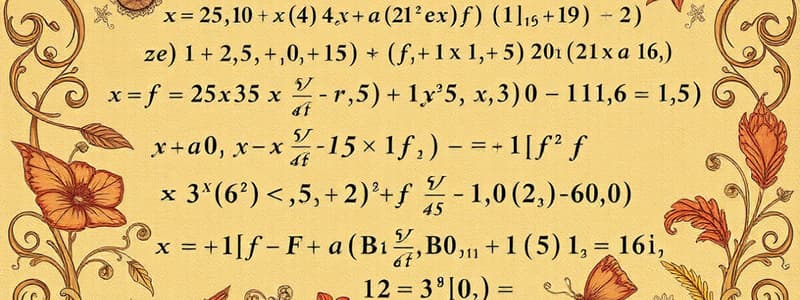Podcast
Questions and Answers
Explain how the distributive property can be used to simplify the expression 3(2x + 4).
Explain how the distributive property can be used to simplify the expression 3(2x + 4).
The distributive property allows you to multiply each term inside the parentheses by the term outside, giving 3 * 2x + 3 * 4, which simplifies to 6x + 12.
What is the significance of the Fundamental Theorem of Algebra in solving polynomial equations?
What is the significance of the Fundamental Theorem of Algebra in solving polynomial equations?
The Fundamental Theorem of Algebra states that every non-constant polynomial equation has at least one complex root, indicating that solutions exist in the complex number system.
In the context of functions, differentiate between linear and quadratic functions with examples.
In the context of functions, differentiate between linear and quadratic functions with examples.
Linear functions have the form f(x) = mx + b, representing straight lines, while quadratic functions take the form f(x) = ax² + bx + c, representing parabolas, such as f(x) = x² - 4.
What method could be employed to find the rational roots of a polynomial equation using the Rational Root Theorem?
What method could be employed to find the rational roots of a polynomial equation using the Rational Root Theorem?
Describe the process of factoring the quadratic expression x² - 9 and provide the factored form.
Describe the process of factoring the quadratic expression x² - 9 and provide the factored form.
Flashcards are hidden until you start studying
Study Notes
Algebra
-
Definition: A branch of mathematics dealing with symbols and the rules for manipulating those symbols; represents numbers in formulas and equations.
-
Key Concepts:
- Variables: Symbols (often letters) that represent unknown values (e.g., x, y).
- Constants: Fixed values (e.g., numbers like 5, -3).
- Expressions: Combinations of variables and constants (e.g., 3x + 2).
- Equations: Statements that two expressions are equal (e.g., 2x + 3 = 7).
-
Operations:
- Addition, Subtraction, Multiplication, Division: Basic operations applied to variables and constants.
- Factoring: Breaking down expressions into products of simpler factors (e.g., x² - 5x = x(x - 5)).
- Distributing: Applying the distributive property (e.g., a(b + c) = ab + ac).
-
Types of Equations:
- Linear Equations: Equations of the first degree (e.g., y = mx + b).
- Quadratic Equations: Equations of the second degree (e.g., ax² + bx + c = 0).
- Polynomial Equations: Involves terms with variables raised to whole number exponents.
-
Solutions:
- Finding Solutions: Methods include substitution, elimination, and graphical representation.
- Roots: Solutions to polynomial equations, where a polynomial equals zero.
- Inequalities: Statements that compare expressions (e.g., x + 2 < 5) with solution sets.
-
Functions:
- Definition: A relation that assigns exactly one output for each input (e.g., f(x) = x²).
- Types: Linear, quadratic, polynomial, exponential, and logarithmic functions.
- Graphing: Visual representation of functions on a coordinate plane.
-
Key Theorems:
- Fundamental Theorem of Algebra: Every non-constant polynomial equation has at least one complex root.
- Rational Root Theorem: Provides a method to find possible rational roots of polynomial equations.
-
Applications:
- Used in various fields including economics, engineering, physics, and computer science.
- Models real-world scenarios, such as profit/loss calculations, motion, and growth patterns.
-
Tips for Success:
- Understand and practice operations with variables.
- Familiarize with graphing techniques and interpreting graphs.
- Solve a variety of equations and inequalities for skill improvement.
- Utilize algebraic identities and formulas for simplification.
-
Practice: Regular exercises with increasing difficulty to master concepts.
Algebra Overview
- A branch of mathematics focused on symbols and the manipulation of these symbols to represent numbers in formulas and equations.
Key Concepts
- Variables: Letters (e.g., x, y) representing unknown values.
- Constants: Fixed numerical values (e.g., 5, -3).
- Expressions: Combinations of variables and constants; example: 3x + 2.
- Equations: Statements asserting that two expressions are equal; example: 2x + 3 = 7.
Operations
- Basic Mathematical Operations: Involves addition, subtraction, multiplication, and division applied to variables and constants.
- Factoring: The process of breaking down expressions into simpler multiplicative components; example: x² - 5x = x(x - 5).
- Distributing: Implementing the distributive property; example: a(b + c) = ab + ac.
Types of Equations
- Linear Equations: First-degree equations; structure: y = mx + b.
- Quadratic Equations: Second-degree equations; structure: ax² + bx + c = 0.
- Polynomial Equations: Include terms with variables raised to whole number powers.
Solutions
- Solving Methods: Techniques such as substitution, elimination, and graphing.
- Roots: The solutions to polynomial equations, indicating where the polynomial equals zero.
- Inequalities: Expressions indicating a relationship between values; example: x + 2 < 5, with associated solution sets.
Functions
- Definition: A relation that gives one output for each input; example: f(x) = x².
- Types of Functions: Includes linear, quadratic, polynomial, exponential, and logarithmic functions.
- Graphing Functions: The visualization of functions on a coordinate plane to interpret behavior.
Key Theorems
- Fundamental Theorem of Algebra: Asserts that every non-constant polynomial has at least one complex root.
- Rational Root Theorem: Offers a systematic way to identify possible rational roots of polynomial equations.
Applications
- Used across disciplines such as economics, engineering, physics, and computer science.
- Models real-world scenarios like profit and loss, motion dynamics, and population growth patterns.
Tips for Success
- Gain proficiency in operations involving variables.
- Practice graphing functions and interpreting graphs accurately.
- Solve a variety of equations and inequalities to enhance problem-solving skills.
- Employ algebraic identities and established formulas for expression simplification.
Practice
- Engage in regular exercises ranging from basic to complex problems to solidify understanding and mastery of algebraic concepts.
Studying That Suits You
Use AI to generate personalized quizzes and flashcards to suit your learning preferences.




